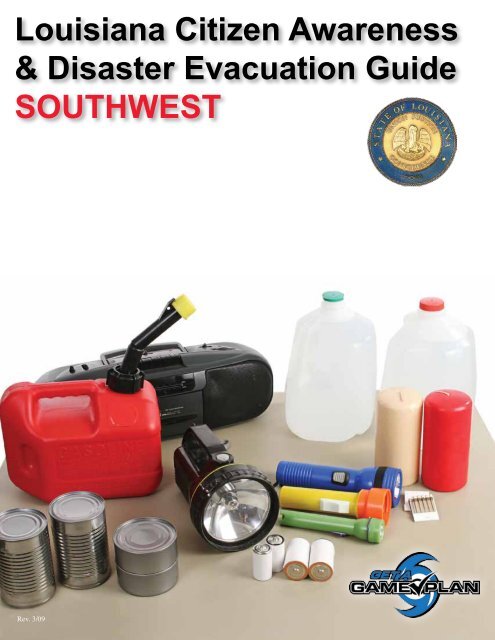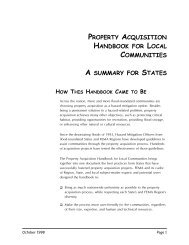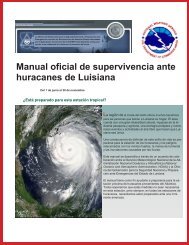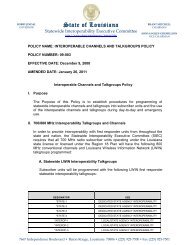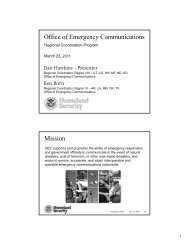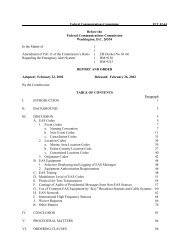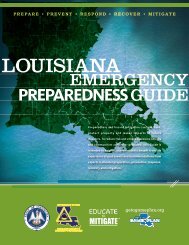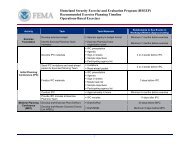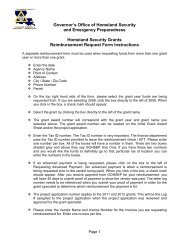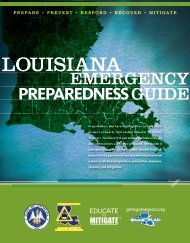Louisiana citizen awareness & disaster evacuation guide southwest
Louisiana citizen awareness & disaster evacuation guide southwest
Louisiana citizen awareness & disaster evacuation guide southwest
Create successful ePaper yourself
Turn your PDF publications into a flip-book with our unique Google optimized e-Paper software.
<strong>Louisiana</strong> Citizen Awareness& Disaster Evacuation GuideSOUTHWESTRev. 3/09
Disasters can occur anywhere at anytime, and at a moment’s notice <strong>citizen</strong>s may need tomove quickly out of harm’s way. Government agencies have planned and are prepared forpossible emergencies that might arise. It is important that you and your family have a planas well.This <strong>guide</strong> will assist you and your family with creating such a plan. I encourage you tostudy this <strong>guide</strong>, so that you can be best prepared to evacuate safely and efficientlyfrom impending threats should the need occur. In the event of an emergency, youshould stay alert and pay attention to the news and announcements in your area soif a situation develops, you are immediately informed. For more information, pleasevisit the Governor’s Office of Homeland Security and Emergency Preparedness athttp://www.ohsep.louisiana.gov/ or www.getagameplan.org.Sincerely,Bobby JindalGovernorFamily Communications PlanSetting up a family communications plan ahead of time will help make sure you and your family can connect aseasily and quickly as possible.• Designate an individual outside of the state to serve as a family point of contact. (After a <strong>disaster</strong>, it’s often easier tocall out-of-state than within the affected area.)• Make sure that all family members know who this person is and how to contact him/her.• After a <strong>disaster</strong> or <strong>evacuation</strong>, all family members should make contact with the designated individual. Try choosinga certain time for everyone to check in.Our Family Evacuation PlanPersonal responsibility is the key to safety during a <strong>disaster</strong>. Ensure your family has a smart and often-practiced plan!Phased EvacuationDuring a threat of a hurricane, a phased <strong>evacuation</strong> will be based on geographic location and time in which tropical stormwinds are forecasted to reach the affected areas.Phase I - 50 Hours before onset of tropical storm winds. Includes areas south of the Intracoastal Waterway.These areas are outside any levee protection system and are vulnerable to Category 1 and 2 storms. These areasare depicted in RED on the Evacuation Map. During Phase I, there are no route restrictions.Phase II - 40 Hours before onset of tropical storm winds. Includes areas south of the Mississippi River whichare levee protected but remain vulnerable to Category 2 or higher storms. These areas are depicted in ORANGEon the Evacuation Map. During Phase II, there are no route restrictions.Phase III - 30 Hours before onset of tropical storm winds. Includes areas on the East Bank of the MississippiRiver in the New Orleans Metropolitan Area which are within levee protection system but remain vulnerableto a slow-moving Category 3 or any Category 4 or 5 storm. These areas are depicted in YELLOW on theEvacuation Map. During Phase III, certain routes will be directed and the Contraflow Plan implemented.Phased <strong>evacuation</strong> procedures are for traffic management purposes only. Consult your local Office of Emergency PreparednessDirector for further <strong>evacuation</strong> information.
EMERGENCY SHELTER INFORMATION POINTSEvacuation Area of the StateInformation Point Location AddressRe-entry from Mississippi onU.S. 65 & U.S. 84Re-entry from Mississippi on I-20From Southeast area on La. 1From Southeast/Central area on I-49From Southeast/Central areas on U.S. 71From Southeast/Southwest/Central areas on U.S.171 & I-49From Southwest on U.S. 171From Southwest/Central areas on U.S. 165From Southeast area on La. 1Tourist Welcome CenterTourist Welcome CenterParagon CasinoSammy’s Truck StopMed Express OfficeP.E. GymLSU-ShreveportPickering High SchoolTourist Information CenterMaddie’s Truck PlazaU.S. 165 & U.S. 841401 Carter StreetVidalia, LA836 I-20 WestTallulah, LAParagon PlaceMarksville, LAI-49, Exit 533601 LA 115 WBunkie, LA7525 U.S. 71Alexandria, LAOne University PlaceShreveport, LA180 Lebleu Rd.Leesville, LA8904 U.S. 165Oberlin, LA15972 La. 1Simmesport, LA
RADIO FREQUENCY SYSTEM• <strong>Louisiana</strong> Emergency Alert SystemThe following radio stations are key participants in the<strong>Louisiana</strong> Emergency Alert System. In the event of anemergency, these stations will broadcast emergencyinformation.AlexandriaAM 970 (KSYL)AM 580/FM 96.9 (KZMZ)FM 93.1 (KQID)Baton RougeAM1150 (WJBO)FM 102.5 (WFMF)CrowleyFM 102.9 (KAJN)LafayetteFM 99.9 (KTDY)Lake CharlesAM 1470 (KLCL)FM 99.5 (KHLA)New OrleansAM 870 (WWL)FM 101.9 (WLMG)NortheastAM 540/FM 101.9 (KNOE)RustonAM 1490 (KRUS)FM 107.5 (KXKZ)ShreveportAM 1130/FM 94.5 (KWKH)• NOAA Weather Radio (NWR)NOAA Weather Radio is a nationwide networkof radio stations broadcasting continuousweather information direct from a nearbyNational Weather Service office. NWRbroadcasts National Weather Servicewarnings, watches, forecasts and otherhazardous information 24 hours a day.SEVERE WEATHER TERMS TO KNOW...Natural <strong>disaster</strong>s most likely to occur in <strong>Louisiana</strong>, particularly inlow-lying areas bordering the Gulf of Mexico, include hurricanes andflooding due to heavy rains. Residents should be familiar with severalterms that describe severe weather conditions:Storm Surge: An abnormal rise of the sea along a shore as the result,primarily, of the winds from a storm.Watch: Adverse conditions are possible in the specified areas of theWATCH, usually within 36 hours. May be applied to thunderstorms,tornadoes, floods, or hurricanes.Warning: Adverse conditions are expected in the specified areaof the WARNING, usually within 24 hours. May be applied tothunderstorms, tornadoes, floods, or hurricanes.MEASURING HURRICANE STRENGTHThe Saffir-Simpson Hurricane ScaleCategory 1: Minimal Damage. Winds 74-95 mph.Storm surge generally 4-5 ft. above normal.Category 2: Moderate Damage. Winds 96-110 mph.Storm surge generally 6-8 ft. above normal.Category 3: Extensive Damage. Winds 111-130 mph.Storm surge generally 9-12 ft. above normal. normal.Category 4: Extreme Damage. Winds 131-155 mph.Storm surge generally 13-18 ft. above normal. normal.Category 5: Catastrophic Damage. Winds greater than 155 mph.Storm surge generally greater than 18 ft. above normal.PUBLIC SHELTER INFORMATIONShelters are operated by trained individuals and ensure thatthe safety. security, and basic needs of its residents are met.What to bring to a shelter?• Change of clothing, blanket, and pillow for eachfamily member• Your <strong>disaster</strong> supply kit, including food,medications, comfort items, and specialitems for infant or elderly family members.What NOT to bring?• There are no weapons, drugs or alcohol allowedSHELTER IN-PLACE INFORMATION“Sheltering in place” is a precaution aimed at keeping <strong>citizen</strong>ssafe while remaining indoors. This is not the same thing asevacuating to a shelter and not recommended for hurricanes.When a “shelter-in-place” order is given by either local or stategovernment, <strong>citizen</strong>s within the affected area should take thefollowing protective measures:• Go indoors and close all windows and doors.• Turn off all sources of outside air (i.e. air conditionersand ventilation fans/ducts).• Remain indoors until notified that it is safe to move outdoors.• Stay tuned to your local radio/television station to receiveofficial notices.• Limit telephone usage to emergency calls only. This is toprevent the telephone lines from being overloaded withnon-emergency calls.The Homeland Security Advisory System,established in March of 2002, is a tool usedto describe threat conditions for a possibleterrorist attack. A color-coded threat levelsystem is used to communicate the fivethreat levels to the American public.Prepare your family for these types ofemergencies by following therecommendations in this <strong>guide</strong> or visitwww.ready.gov. For more information onHomeland Security advisories, visit theGovernor’s Office of Homeland Securityand Emergency Preparedness link:www.ohsep.louisiana.gov/homeland/HSThreatAdvisory.thm.WHAT TO DODURING ACHEMICAL ORBIO-HAZARDRELEASEIF YOU MUST BEOUTDOORS...Protect your breathingby covering your mouthand nose with a cloth orhandkerchief.IF YOU ARE IN YOURVEHICLE AND CAN’TGET TO A SAFEBUILDING...1. Pull over to the side ofthe road.2. Turn the engine off andclose the windows andvents.3. Listen to the radioregularly for updatedadvice, instructionsand conditions.
Family Disaster Supply KitThere are six basics that you should stock for your <strong>disaster</strong> supply kit: water, food, clothing and bedding, first aid supplies,tools and emergency supplies and special items. Keep these items in a waterproof container that can be easily transportedfrom your home to your car and your safe place. Assemble your kit now to allow for immediate action during anemergency. Your family’s <strong>disaster</strong> supply kit should include at least a three-day supply of:• Water - One gallon of water per person per day• Non-perishable food - Select food items that are compact and lightweight. Include the following items:° Ready-to-eat canned meats, fruits and vegetables° Canned juices° High energy foods° Vitamins° Comfort goods° Condiments° Food for infant• Clothing and bedding - Include at least one complete change of clothing and footwear per person and thefollowing weather-appropriate items:° Sturdy shoes or work boots° Rain gear° Blankets or sleeping bags° Hat and gloves° Thermal underwear° Sunglasses• First aid supplies – Assemble a first aid kit for your home and one for each car.• Tools and emergency supplies° Emergency preparedness manual ° Battery-operated radio and extra batteries° Flashlight and extra batteries ° Cash or traveler’s checks, change° Non-electric can opener, utility knife ° Fire extinguisher: small canister ABC-type° Tube tent ° Pliers° Tape ° Compass° Matches in a waterproof container ° Aluminum foil° Plastic storage containers ° Signal flare° Paper, pencil ° Needles, thread° Medicine dropper ° Shut-off wrench to turn off household gas and water° Whistle ° Plastic sheeting° Sanitation supplies ° Official DOTD Highway Map° <strong>Louisiana</strong> Citizen Awareness and ° Mess kits, paper cups, plates and plastic utensilsDisaster Evacuation Guide• Special ItemsInfant and medical supplies: Remember supplies for family members with special requirements, such asinfants, elderly, persons with disabilities and persons taking medication• Entertainment - Games and books• Important family documents° Wills, insurance policies, contracts, deeds, stocks and bonds° Passports, social security cards and immunization records° Bank account numbers° Credit card account numbers and company addresses° Inventory of valuable household goods and important telephone numbers° Family records (birth, marriage, death certificates)Store your kit in a convenient place known to all family members. Keep a smaller version of the supply kit in the trunk ofyour car. Change your stored water supply every six months so it stays fresh. Replace your stored food every six months.Re-think your kit and family needs at least once a year. Replace batteries, update clothes, etc.
GET A GAME PLANFor more information or for extra copies of the <strong>Louisiana</strong> CitizenAwareness & Disaster Evacuation Guide, please contact:<strong>Louisiana</strong> State Police1-800-469-4828American Red Cross1-800-RED-CROSS1-800-733-2767Governor’s Office of Homeland Security& Emergency Preparedness1-225-925-7500LetsMitigate.comPrinted with fundsprovided by theU.S. Department ofHomeland Security


